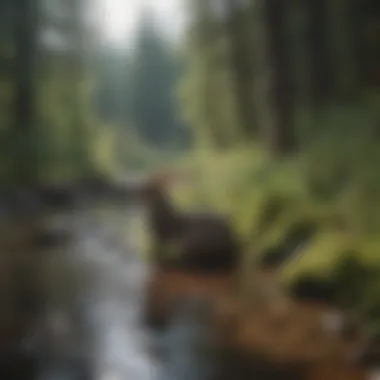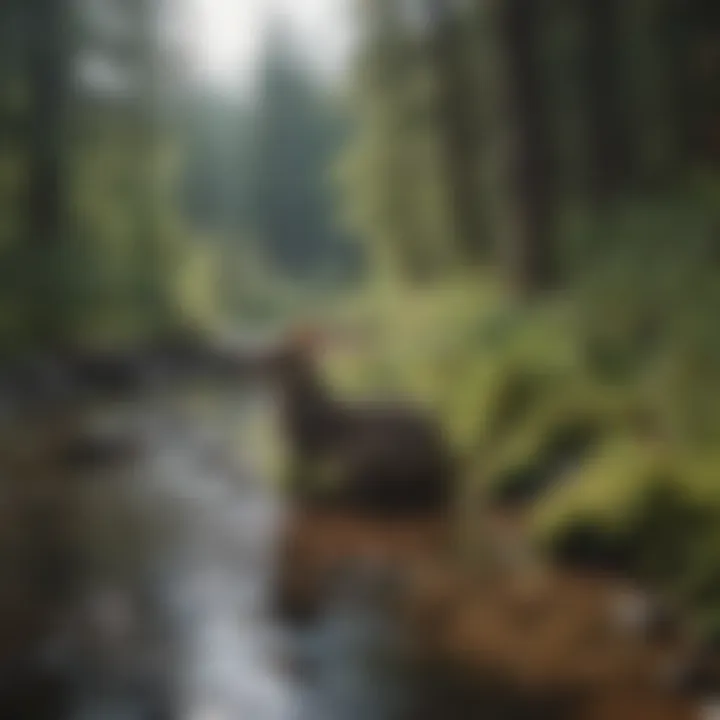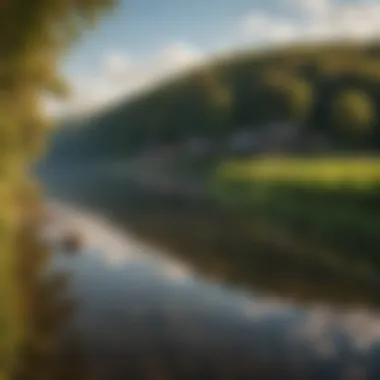Exploring New York: Nature, History, and Conservation


Overview of the Topic
New York's natural landscape is a vibrant tapestry woven with rich histories, diverse ecosystems, and the ongoing struggle between development and conservation. From the windswept peaks of the Adirondacks to the lush valleys of the Hudson River, the state offers a remarkable display of nature's bounty, teeming with flora and fauna that have flourished for centuries. However, this picturesque scenery comes with its own set of challenges, particularly in how communities interact with the environment.
This article digs into the significance of New York's natural resources and ecosystems, highlighting not just their beauty but also the environmental issues that threaten them. Understanding these landscapes is more than an exercise in appreciation; it’s crucial for fostering sustainable practices that protect these resources for future generations. Local communities play an essential role in this—often finding themselves caught in the crosshairs of development pressures and the need for conservation.
Current Status and Challenges
As it stands, New York's ecosystems face numerous pressures from urban expansion, climate change, and pollution.
- Urban Development: Increased population density in urban centers leads to habitat destruction. The expansion of concrete jungles often comes at the expense of wetlands and forests, crucial for biodiversity.
- Climate Change: Changes in climate patterns have serious implications for both human and wildlife populations. Temperature shifts affect seasonal cycles, ultimately influencing when species breed, migrate, or hibernate.
- Pollution: Industrial pollutants and agricultural runoff compromise water quality in rivers and lakes, directly affecting aquatic life and the overall health of ecosystems.
"The balance between human activities and ecological integrity must be managed wisely; otherwise, we risk losing irreplaceable natural treasures."
Recognizing these challenges is the first step towards addressing them. The intertwining impacts of local actions and global issues underscore the urgent need for a strategy to promote sustainable use.
Sustainable Solutions
A vital part of conserving New York's natural landscapes lies in identifying and applying effective sustainable practices. Citizens and organizations are actively working to mitigate the adverse effects mentioned earlier.
Here are some notable approaches:
- Restoration Projects: Initiatives to restore wetlands have gained momentum. Wetlands serve as natural buffers against flooding while providing critical habitats for many species.
- Community Involvement: Local groups, such as the New York Natural Heritage Program, focus on educating citizens about biodiversity and promoting stewardship of local ecosystems. Their efforts help breed a culture of sustainability in communities.
- Regeneration Practices: Sustainable agriculture methods are being embraced to enhance soil health and reduce runoff, ensuring that farms can coexist with healthy ecosystems.
These actions highlight the potential for existing resources to be managed in a way that supports both environmental health and human needs.
Impact and Importance
The health of New York’s natural landscapes resonates far beyond its boundaries. Local ecosystems contribute to air and water quality, support recreational opportunities, and enhance property values. The impact on communities is profound, with accessible green spaces promoting both physical health and mental well-being.
Preserving these landscapes for future generations is paramount. Sustainable practices ensure that we do not deplete resources today while grazing lightly on tomorrow. The continued efforts of conservation groups and local citizens stand as a testament to the bond humans share with nature—a bond that, if nurtured, can lead to a sustainable coexistence.
In summary, understanding and addressing the challenges faced by New York's landscapes not only aids in conservation but also enriches the lives of both current and future residents. The path forward must be paved with respect for the environment and an ongoing commitment to sustainability.
Historical Context of New York's Landscapes
The landscapes of New York hold a mirror to the story of human interaction with nature. To comprehend the modern state of its environments, one must venture back in time to understand how historic events shaped them. This historical context not only unravels the patterns of land use, but it also illustrates the consequences of those practices on ecological systems. Knowing this background presents a clearer picture of how we arrived at today’s environmental challenges and the landscape's overall health. Therefore, delving into the rich tapestry of New York's history, from the stewardship of indigenous peoples to the urban sprawl influenced by industrialization, is fundamental in evaluating current land use policies and practices.
Indigenous Peoples and Land Stewardship
The indigenous tribes of New York, like the Iroquois and Algonquin, held a profound connection to the land, viewing it not simply as property but as a sacred entity deserving of respect. Their understanding of sustainable practices allowed them to thrive in harmony with the environments around them. They employed methods like fire to manage forests and support game populations, ensuring that resources were available for generations. This intimate connection has profound examples, such as the Three Sisters agricultural method, which involved growing corn, beans, and squash together. This technique not only maximized food production but also enriched the soil, highlighting a sophisticated understanding of ecosystem interdependence long before modern conservation concepts were popularized. The lessons from these practices remind us of the potential for land stewardship, insisting that today's policies should look back to indigenous wisdom as a path to sustainability.
Colonial Expansion and Its Environmental Impacts
With the arrival of European settlers in the 17th century, New York underwent drastic transformations. Colonial land expansion set into motion a cascade of environmental changes that have had lasting impacts. Deforestation, driven largely by the need for timber to build homes and ships, altered entire ecosystems, pushing wildlife deeper into the uncharted territories. Furthermore, the introduction of agricultural practices which favored monoculture over diverse ecosystems disturbed the balance found in prior land use. As colonists transformed vast forests into farmland, natural habitats for many species diminished. Notably, the beaver population, once abundant, faced severe decline due to overtrapping for the fur trade. This over-exploitation laid the groundwork for biodiversity loss and set the stage for future environmental challenges that contemporary New Yorkers continue to grapple with.
Industrial Growth and Urbanization
The Industrial Revolution marked a significant chapter in New York's development, with its cities rapidly expanding due to influxes of both immigrants and industry. Urbanization brought about a new relationship with the landscape. Factories, railroads, and shipping routes cropped up, dramatically altering the land use. The natural beauty of New York, particularly areas like the Hudson River Valley, was overshadowed by the smoke stacks and innovation that defined progress at that time. Pollution became a prevalent issue, affecting air and water quality and contributing to health problems among the residents. Environmental consequences were not solely localized; they rippled outward, causing shifts not only in local ecosystems but also in human health and wellbeing. Urbanization has fundamentally reshaped how New Yorkers interact with the surrounding nature, often leading to a disconnect from traditional land stewardship principles.
Geographical Diversity in New York State
Geographical diversity in New York State serves as the backbone of its remarkable ecosystems, providing residents and visitors alike with an array of landscapes that are not only visually captivating but also ecologically significant. Understanding this diversity is crucial for conservationists and environmentalists alike as it emphasizes the interconnectedness of various habitats and the vital role they play in maintaining ecological balance.
From towering mountains to serene lakes and vibrant coastal areas, New York is a treasure trove of different geographical features. Each region offers unique benefits, considerations, and habitats that contribute to the state's overall biodiversity. The interplay of these environments shapes local climate, flora, and fauna, none of which can be overlooked when discussing land preservation and sustainable practices.
Mountains and Forests
The Adirondacks and Catskills are two prominent mountain ranges in New York, known for their rugged terrain and expansive forests. These areas are more than just a sight for sore eyes; they are crucial for biodiversity as they serve as habitats for numerous species of plants and animals. The diversity found in the forest ecosystems here ranges from majestic hardwoods to distinctive conifers. This diversity not only supports wildlife but also plays an essential role in carbon sequestration, helping to mitigate the impacts of climate change.
Additionally, the forests act as natural water filters, purifying rainwater before it reaches streams and rivers. This highlights a compelling interaction between geographic features and the health of local ecosystems:


- Water Cycle: Healthy forests ensure a regular water cycle, which is necessary for sustaining local wildlife.
- Wildlife Corridors: Mountains provide vital corridors that connect different habitats, allowing species to thrive and adapt.
Lakes and Rivers
Lakes and rivers are vital components of New York's geography. The Finger Lakes region, for instance, is famous for its picturesque bodies of water that harbor diverse aquatic ecosystems. These lakes not only support recreational activities but also play a role in local economies. They provide habitats for fish and other aquatic animals, contributing to robust ecosystems that are crucial for maintaining ecological balance.
Rivers like the Hudson and Mohawk are arteries for various communities and wildlife. They serve multiple purposes:
- Biodiversity Hotspots: They are breeding grounds for vital fish species, including brook trout and various migratory species.
- Transportation and Economy: Historically, rivers have allowed for transportation and trade, contributing to the growth of towns and cities along their banks.
- Flood Control: Well-maintained river ecosystems can absorb water during heavy rains, mitigating flood risks in surrounding areas.
Coastal Ecosystems
As New York State stretches along the Atlantic seaboard, its coastal ecosystems are crucial for both wildlife and humans. Marshes, estuaries, and shorelines provide critical habitats for numerous species, including migratory birds and marine life. These areas function as nurseries for various fish species, contributing to the health and sustainability of marine biodiversity.
Coastal locations also endure constant challenges, including the effects of climate change and human activities. A few important roles these ecosystems provide include:
- Protection from Storm Surges: Coastal wetlands act as buffers against storms, reducing the impact on inland communities.
- Nutrient Cycling: They play a significant role in nutrient cycling, benefiting both land and marine ecosystems.
- Recreation and Tourism: Coastal areas attract millions of visitors, highlighting the economic significance of maintaining these natural landscapes.
In summary, New York's geographical diversity is essential for its ecological integrity. The mountains, lakes, rivers, and coastlines work together to form a rich tapestry of ecosystems that need to be preserved for future generations. Understanding their significance is the first step towards responsible stewardship of these lands.
Biodiversity in New York
Biodiversity refers to the variety of life forms in a given ecosystem, and in New York, it’s a rich tapestry. This state has a unique blend of environments—from the dense forests of the Adirondacks to the complex wetlands of Long Island. The importance of understanding New York's biodiversity cannot be overstated. It supports ecosystem stability and resilience, providing essential services which humans often take for granted.
By maintaining diverse biological communities, the state ensures healthier ecosystems that can adapt more readily to changes, whether from natural events or human action. Each species plays a role, influencing resources that support both wildlife and human populations.
"In nature, nothing exists alone." - Rachel Carson
Here are some key points about New York's biodiversity:
- Ecosystem Services: Biodiversity is critical for services such as clean air and water, pollination of crops, and regulation of climate.
- Cultural Value: The natural diversity also enriches New Yorkers' cultural identity, providing recreational opportunities and aesthetic value.
- Research and Education: The rich array of species can deepen scientific inquiry and foster educational pursuits, influencing upcoming generations.
Ultimately, New York's biodiversity isn't merely a statistic; it’s woven into the very fabric of what makes the state's natural landscape vibrant and dynamic.
Flora: Unique Plant Species
New York's flora bursts with uniqueness, showcasing species across its various climates and geographies. Some plants are iconic and hold historic significance, like the Eastern Hemlock, which is prevalent in many of New York's forests, offering shelter and sustenance for numerous species.
Other notable plants include:
- New York Ironweed: A striking wildflower often found in meadows, it adds vibrant purple hues to the landscape and supports butterflies and other pollinators.
- Pitch Pine: Thriving in sandy soils, this tree is resilient, and its ecological role is crucial in forest regeneration, particularly after fires.
- Wild Blueberry: These shrubs not only produce sweet fruit but also provide food for many wildlife species.
Unique plants not only contribute to ecological balance but also offer potential benefits in medicine and gardening. They play a vital role in nurturing habitats that sustain diverse animal life.
Fauna: Iconic Animal Species
Animal diversity in New York is as rich as its plant life, with countless species adapted to thrive in varied environments. The state is home to many classic representatives of fauna.
Some species worth noting include:
- Eastern Bluebird: A symbol of happiness, this bird has vibrant colors and is a vital indicator of ecosystem health.
- American Bald Eagle: Once endangered, this magnificent bird has made a comeback, emblematic of successful conservation efforts and an essential predator in the food chain.
- White-tailed Deer: Common in many areas, they shape vegetation and are a crucial part of the forest ecosystem.
These creatures embody the spirit of New York’s wilderness, reminding us of the delicate balance required for their continued survival alongside human development.
Ecosystem Interdependence
The connection between species in New York's ecosystems is a defining feature of its biodiversity. Each plant and animal has a role, creating a web of interdependence that enhances the resilience of the overall ecosystem. For example, the loss of one species can ripple through the food chain, affecting predators and prey alike.
- Pollination: Plants rely on animals for reproduction. Bees, birds, and other creatures facilitate this process, ensuring a diverse array of plant species continues to thrive.
- Nutrient Cycling: Decomposers like fungi and bacteria break down dead organic matter, returning nutrients to the soil, which supports plant growth.
- Habitat Creation: Beavers build dams that create wetlands, essential for many amphibious and aquatic species.
Understanding these connections is crucial for effective conservation strategies. By fostering an appreciation of how intertwined life truly is, we can make informed decisions to protect these shared ecosystems. The delicate balance of life in New York's biodiverse world is a testament to nature’s remarkable ability to adapt and thrive.
Land Use and Resource Management


Understanding land use and resource management in New York is not just an academic exercise; it’s a crucial part of ensuring the sustainability of the state’s diverse ecosystems. New York, with its blend of urban and rural landscapes, faces unique challenges in balancing development needs with environmental preservation. This arena encompasses agriculture, forestry, and mining, each of which carries significant weight in shaping the ecological and economic future of the region.
In any discussion about land use, it's essential to recognize how these practices impact the environment. Poor management can lead to soil degradation, water scarcity, and biodiversity loss. On the flip side, well-planned strategies can yield benefits like enhanced food security, healthier forests, and sustainable communities. The journey towards a more sustainable future hinges on finding that delicate balance.
Agriculture and Its Environmental Footprint
Agriculture occupies a substantial part of New York's land area, from the Hudson Valley’s orchards to the vast fields of corn and soybeans in Western New York. However, its environmental footprint carries consequences that cannot be ignored.
- Soil Erosion: Intensive farming practices can lead to soil erosion, washing away vital nutrients. Over time, this decreases soil fertility, making it harder for farmers to maintain productivity.
- Water Usage: The agricultural sector consumes a large amount of water, often at the expense of local ecosystems. If not managed wisely, this can lead to depletion of freshwater sources, impacting both wildlife and human communities.
- Pesticides and Fertilizers: Heavy reliance on chemical inputs not only pollutes waterways but also threatens the health of insects and other wildlife. For instance, the decline of bee populations is linked, at least partially, to pesticide usage.
Agriculture can play a pivotal role in conservation if methods such as crop rotation and organic practices are adopted. These methods not only mitigate negative impacts but also enhance resilience against climate variability.
Forestry Practices and Sustainability
Forestry in New York presents a dual-edged sword; it offers resources and job opportunities but can also result in significant ecological damage if not managed sustainably. Forests serve as critical habitats for wildlife and help in carbon sequestration, making responsible forestry practices vital.
- Sustainable Logging: This involves practices that minimize environmental impact, such as selective logging that reduces damage to surrounding trees and allows for natural regeneration.
- Forest Conservation: Areas like the Adirondacks serve as vital carbon sinks and biodiversity hotspots. Protecting these lands from development is essential for maintaining ecological balance.
- Community Forestry: Engaging local communities in forest management promotes stewardship. When people have a stake in their resources, they are more likely to support sustainable practices.
If New York’s forests are to remain robust, innovative approaches to forestry that emphasize sustainability must gain traction.
Mining and Resource Extraction
Mining in New York has been a significant part of its economic history, providing essential minerals and resources. However, the environmental toll of mining cannot be understated.
- Land Degradation: Mining activities often lead to significant land disturbance, which can result in habitat loss, soil erosion, and water contamination.
- Regulation and Oversight: Strong regulatory frameworks are critical. New York has laws in place to govern mining practices, but there’s an ongoing need for oversight to ensure compliance and environmental protection.
- Rehabilitation of Sites: Post-mining land rehabilitation is essential. Without it, once-extracted areas can become wasteland, unable to support wildlife or plant life.
In an era where renewable energy is becoming more prominent, there’s potential for shifting focus toward sustainable extraction practices, ensuring that New York can meet its resource needs while protecting its landscapes.
"Sustainability is not just about doing less harm. It’s about doing more good."
Conservation Efforts and Challenges
Preserving the natural landscape of New York State is not just an endeavor; it's a necessity for maintaining biodiversity, ensuring clean water, and fostering a sustainable future for all species that inhabit this region. The idea of conservation has taken root deeply, morphing over time into various programs and initiatives aimed at protecting the environment. These efforts are paramount, not only for the flora and fauna of New York but also for the communities intertwined with these landscapes. This section delves into the critical conservation structures in place, the collective involvement of communities, and the obstacles that conservation initiatives face today.
Protected Areas and Wildlife Refuges
Protected areas serve as sanctuaries for countless species, ranging from the common to the endangered. In New York, there are numerous state parks, wildlife refuges, and nature preserves designed to shield delicate ecosystems from degradation. Places like the Adirondack Park, which is one of the largest protected areas in the contiguous United States, exemplify how vast stretches of wilderness can thrive when safeguarded from development.
Moreover, wildlife refuges, such as the Monteverde Wetlands and Iroquois National Wildlife Refuge, play critical roles in offering safe havens for migratory birds and other wildlife. These lands are vital for maintaining ecosystem integrity and serve as crucial feeding and breeding grounds. The establishment of these protected zones illustrates a proactive approach toward fostering biodiversity, ensuring these habitats remain intact for future generations.
"When we protect nature, we protect ourselves!"
Community Involvement in Conservation Programs
Community engagement is the backbone of effective conservation. Many local organizations and grassroots movements have sprung up across New York, creating a bridge between residents and their natural surroundings. Initiatives like the New York State Conservation Partnership Program encourage community groups to spearhead projects that preserve local habitats and promote educational outreach.
Folks participate in a variety of activities: tree planting events, clean-up drives at local parks, and educational workshops about native species. There’s an undeniable energy in these gatherings; they not only foster a sense of community spirit but also instill environmental stewardship among participants. When people feel connected to their environment, they tend to be more invested in its future.
Furthermore, social media has become a powerful tool in mobilizing community support. For instance, groups on Facebook and forums like Reddit allow people to exchange ideas, share results of local clean-ups, and rally for conservation causes. This approach illustrates a modern twist on how community collaboration can effectively face environmental challenges.
Challenges to Conservation Initiatives
Despite the enthusiasm for preserving New York’s landscapes, numerous challenges persist. Funding often stands as a significant barrier. While grants and donations come from various sources, they may not always meet the growing needs of conservation projects. Unexpected expenses can crop up, putting pressure on organizations that already work within tight budgets.
Moreover, climate change poses a persistent threat. Rising sea levels, increased flooding, and unpredictable weather patterns are transforming the environment in ways that can outpace the adaptability of both ecosystems and the human systems built around them. For example, wetlands, which act as natural buffers against storms, are disappearing at an alarming rate due to both development pressures and climate changes.
In addition, policy challenges can stall conservation efforts. Legislation needs to keep pace with the rapid changes affecting the environment, and oftentimes it doesn’t. The tug-of-war between development interests and conservation priorities can lead to conflicts, with nature suffering as a result.
The Impact of Climate Change
Understanding climate change is essential to grasping the landscape of New York. These changes affect natural resources and disrupt ecosystems that have thrived for centuries. The climate crisis looms large, posing not just ecological threats but also economic and social ones. Agriculture is vulnerable, biodiversity faces affliction, and communities encounter rising sea levels, among other repercussions. Addressing these impacts will demand collaboration across government, businesses, and local communities. In this section, we will explore how these shifts affect New York’s famous natural habitats and how people are adapting and responding to these urgent challenges.
Effects on Natural Habitats


The fingerprints of climate change are far from subtle; they can be seen etched into New York’s landscapes. As temperatures begin to fluctuate more erratically, habitats are struggling to keep pace. The melting of the glaciers in the Adirondacks, once a bastion for various species, creates ripples through the local ecosystem.
- Changes in plant communities: Some species find refuge in the higher elevations, while others could face extinction.
- Increased competition among species: Non-native species often thrive in warming conditions, shifting the balance.
- Altered migration patterns: Birds and other animals may find their seasonal movements disrupted, leading to mismatched breeding patterns.
- Threats to aquatic ecosystems: Warmer water temperatures impact fish populations, particularly trout, which require cooler waters to thrive.
"As we witness these environmental shifts, the consequences unfold like a domino effect, touching each layer of the ecosystem."
These ongoing changes unveil the fragility of these habitats and the intricate web of life that depends on them. The pain of loss can only be mitigated through awareness and understanding of these dynamics.
Adaptation Strategies for Ecosystems
In the face of these changes, New York has begun to adapt. The planning efforts encompass not only natural resource management but also investments in green infrastructure. Such strategies aim to bolster resilience against climate impacts while safeguarding ecosystems.
- Restoration of natural habitats: Many organizations are working to restore wetlands and forests, vital for biodiversity.
- Establishment of wildlife corridors: Creating pathways allows species to migrate safely as their natural habitats shift.
- Sustainable agriculture practices: Shifting focus to organic and regenerative farming can help improve soil health and reduce runoff.
- Research and monitoring: Collaboration with universities and research institutions helps track changes and inform policy.
These approaches not only target immediate threats but also aim to foster long-term resilience, forming a backbone for sustainable development in the face of climate change.
Community Responses to Climate Challenges
Local communities are often the first responders to climate change impacts. New Yorkers are mobilizing to forge a collective response to the looming crises.
- Grassroots advocacy: Groups like the Sierra Club and local activists are raising awareness and pushing for policy changes.
- Community gardens and urban agriculture: These grassroots initiatives promote food security while building local resilience.
- Workshops and education: Schools and organizations are hosting events focusing on environmental stewardship and sustainability.
- Partnerships with local government: Engaging with the state’s environmental policies helps communities influence decisions.
The role of individuals and local groups cannot be overstated. Their actions ripple outwards, becoming a powerful force for change.
Ultimately, the document reveals an urgent need for measures to mitigate climate change effects, ensuring that New York’s unique landscapes survive for future generations. The ongoing dialogues between community residents, scientists, and policymakers are imperative to create a balanced, sustainable future.
Future Directions for Land Use Policy
The landscape of New York is not merely defined by its physical attributes but also by the policies that govern its use. As we navigate a world increasingly aware of environmental concerns, the direction of land use policy in New York takes center stage. Creating balanced, sustainable development practices helps ensure our natural resources can thrive for future generations while also accommodating the state's growing population and its diverse needs.
Sustainable Development Practices
Sustainable development isn't just a buzzword; it's a crucial framework for future policies concerning land use. This approach integrates economic growth with environmental stewardship, ensuring that both the present and future enjoy the benefits of our natural landscapes. Practices like mixed-use zoning foster communities where work, leisure, and nature coexist harmoniously. For instance, New York's waterfront areas like the Brooklyn Bridge Park serve as exemplary models where recreation and habitat restoration go hand-in-hand.
Considerations for sustainable practices also involve utilizing green infrastructure—like permeable pavements and rain gardens—to manage stormwater more effectively. This not only mitigates flooding risks but also revitalizes our urban spaces.
Policy Framework for Resource Management
A robust policy framework is pivotal for any successful resource management strategy. This framework should be dynamic enough to adapt to changing environmental conditions and community needs. Policies may focus on minimizing waste through recycling and composting, effectively managing forests for timber production while ensuring biodiversity preservation, or regulating how agricultural development interacts with natural habitats.
For instance, New York's implementation of the Regional Greenhouse Gas Initiative (RGGI) illustrates a proactive measure where emissions from the power sector are capped, further promoting the use of cleaner energy sources. It represents a collective effort by several states to curb pollution, showcasing how cooperative policies can amplify resource management efforts and combat climate change.
Engagements with Stakeholders
Strong engagement with stakeholders—ranging from government entities, local communities, to environmental groups—is essential in shaping future land use policies. Engaging local residents in discussions can yield invaluable insights. They often possess profound knowledge about their immediate environments, which can significantly influence sustainable decision-making processes.
Moreover, involving stakeholders in the drafting of policies fosters a sense of ownership and responsibility toward our natural resources. Programs such as community land trusts allow residents to participate actively in land management and conservation. This bottom-up approach can lead to creative solutions tailored to specific local needs, unlike blanket policies that might miss the mark.
"Listening to the local people is like deciphering the many dialects of nature itself; each voice holds a lesson that can navigate our policies in a more effective direction."
In summary, the future directions for land use policy in New York hinge on fostering sustainable methods, establishing robust policy frameworks, and actively involving stakeholders in the decision-making process. By doing so, New York can ensure that its natural landscapes are preserved, respected, and utilized wisely for generations to come.
Closure: A Call for Responsible Stewardship
The coastal, mountainous, and forested expanses of New York represent more than just scenic beauty; they are a testament to the intricate balance between nature and human existence. As the world wrestles with mounting environmental issues, New York stands at a crossroads, where the actions of today can dramatically influence the future of its landscapes. Understanding the importance of responsible stewardship is not just a matter of environmental concern but an urgent call to action for those who cherish and rely on these natural resources.
Importance of Community Action
Communities play a pivotal role in shaping their local environments. Whether it's a small village along the Hudson River or a bustling urban area like Brooklyn, grassroots efforts can lead to significant outcomes in conservation. Community action fosters a shared responsibility among its members, encouraging citizens to engage in practices that protect their surroundings. For instance, local initiatives like river clean-up days or urban gardening have risen in popularity, showcasing how simple actions can yield substantial results. Moreover, involving people from diverse backgrounds promotes inclusivity, ensuring that every voice is heard in the conversation about land stewardship. The power of collective action, where neighborhoods unite for a common purpose, can be the driving force behind effective environmental change.
The Role of Education in Environmental Awareness
Education emerges as a cornerstone of sustainable practices. By integrating environmental science into classroom curricula, young minds are equipped with the tools to comprehend their impact on nature. Schools and community programs are increasingly focusing on fostering an educational environment that emphasizes the significance of ecosystems. Field trips to local parks, workshops on recycling, and presentations by conservationists bolster a deeper understanding of the intricate connections within our natural world. Education doesn't stop at a young age; public seminars and online platforms serve to inform adults as well. A well-informed populace is more likely to support sustainable practices and hold its leaders accountable.
Vision for Future Generations
The essence of stewardship lies in its potential to create a better tomorrow. Future generations will inherit the landscapes that we choose to protect today. It’s crucial to envision a New York where thriving ecosystems coexist with urban life, where efforts in conservation lead to restored habitats and biodiversity. Forward-thinking initiatives—such as integrating green spaces into new developments or expanding protected areas—promise to preserve the state’s natural heritage. The responsibility rests on our shoulders to not only prepare our landscapes for adversity but also to sow seeds of resilience that will endure for decades.
"The real voyage of discovery consists not in seeking new landscapes, but in having new eyes."
— Marcel Proust



